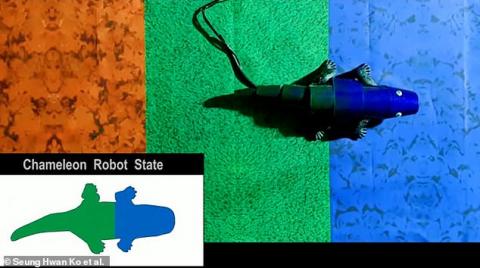
A soft robot that can change colour in real-time to match its background like a chameleon could pave the way to new forms of military camouflage.
The 'artificial chameleon skin' that covers the segmented back of the walking plastic-bodied robot was developed by a team led from the Seoul National University.
Built to resemble the animal, the little walking robot is 1 foot and 3 inches (38 cm) long, some six inches (15 cm) wide and weighs in at 2 lbs (0.9 kg).
Footage of the chameleon bot shows it walking across a background with stripes in different colours and textures, which it studies with its sensors.
As it crosses each stripe, the segments on the robots back gradually change hue to match, phasing from an orange–red to green and finally a rich blue.
Other applications for the tech might include the creation of flexible, wearable displays and to make cars or buildings that could change colour as the user desires.
HOW THE BOT WORKS
The chameleon robot has sensors which analyse the hue and pattern of the surfaces over which it walks.
Its skin, meanwhile, combines temperature driven colour change liquid crystal layers with vertically stacked, patterned silver nanowire heating networks.
These heat the liquid crystals such that they gently change to match the colour of the background as detected by the sensor.
'The ultimate form of this application will be an invisibility cloak — by blending into the background,' said paper author and mechanical engineer Seung Hwan Ko of the Seoul National University in South Korea.
He added: 'For the military, it would make a great covert intelligent scout robot — and impossible for the enemy to notice.
'It also opens the door to actively camouflage a soldier.
'Current military uniforms are "passive". They have a fixed colour and patterns that cannot reflect the change of surrounding.'
In contrast, active camouflage would be able to change their appearance to better blend in with the background.
Realising such abilities technologically, however, has long been a challenging feat, as artificial camouflage devices need to be able to display a wide range of possible colours that can be changed on demand and reflect fine background details.
In their study, Professor Ko and colleagues achieved this using a novel strategy that combines integrated thermochromic (temperature driven colour change) liquid crystal layers with vertically stacked, patterned silver nanowire heating networks.
Colour sensors and feedback systems built into the robot detect the local background colour, and then transitions the colour of its skin in order to match.
Stealth and camouflage applications are not the only uses that the team conceive for their artificial chameleon skin technology.
'You may imagine a cloth that changes its colour and patterns according to your taste or environment,' Professor Ko said.
'Other applications include active background adaptions for '"cosmetic" or "aesthetic" purpose, cars, clothes or buildings.
'In addition, this chameleon technology can be used for future flexible and wearable displays.'
The researchers created their artificial chameleon skin by combing integrated thermochromic (temperature driven colour change) liquid crystal layers (left and middle) with vertically stacked, patterned silver nanowire heating networks (left and top right).
Colour sensors and feedback systems built into the robot detect the local background colour — and then transitions the colour of its skin in order to match.
At present, the robot chameleon developed by the researcher is a little larger than the real thing.
However, with their initial study complete, the team are hoping to be able to scale down the design.
In addition, the team are looking to give the robot the ability to reflect the textures of background surfaces with greater resolution, a feat they say may be attainable with advances in signal processing and data-driven science.
'The ultimate form of this application will be an invisibility cloak — by blending into the background,' said paper author and mechanical engineer Seung Hwan Ko of the Seoul National University in South Korea. Pictured: the robot, which is black when powered off, changes its skin colour as it walks across a multicoloured surface.